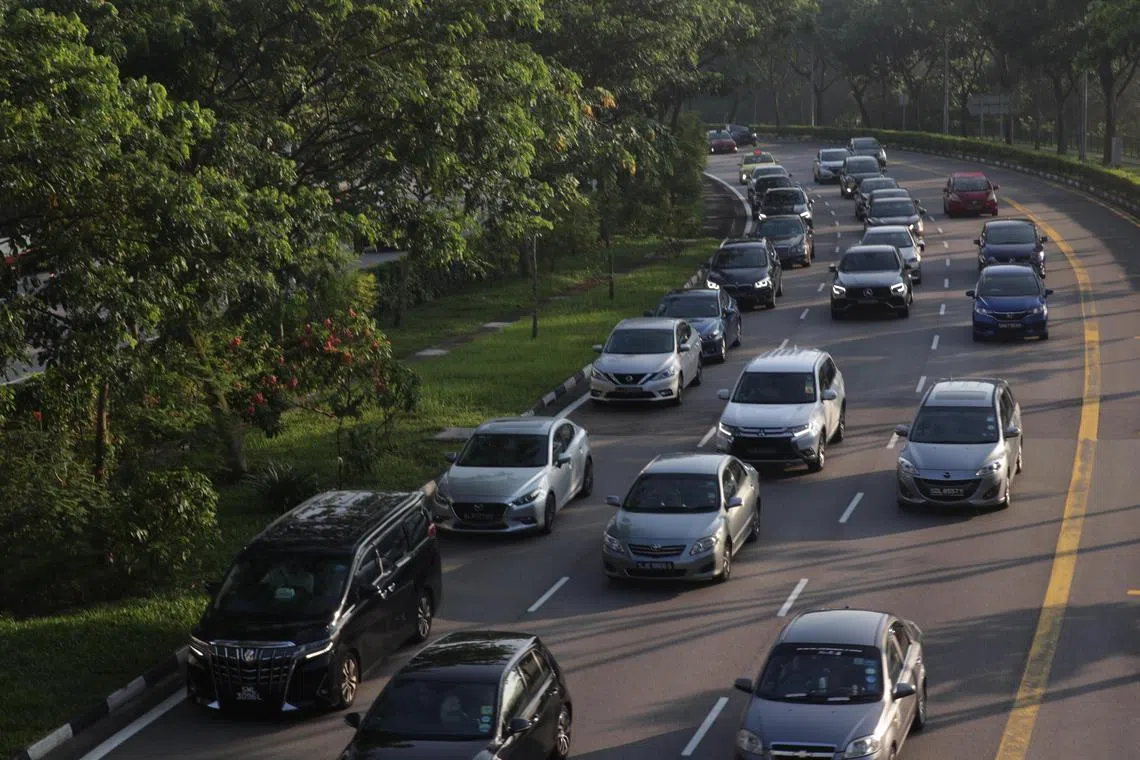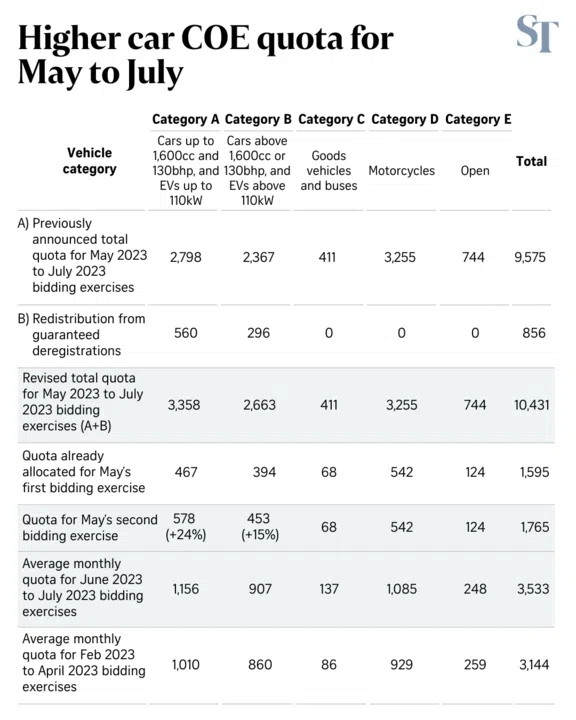Car COE supply to rise by 24% for Cat A, 15% for Cat B till July in one-time adjustment
Sign up now: Get ST's newsletters delivered to your inbox

The COE quota for May 2023 to July 2023 will be increased from 9,575 to 10,431, said LTA.
ST PHOTO: GIN TAY
Follow topic:
SINGAPORE - The supply of certificates of entitlement (COEs) will increase by 24 per cent for smaller, less powerful cars (Category A) and 15 per cent for bigger, more powerful cars (Category B) for the current three-month quota period till July.
Transport Minister S. Iswaran told Parliament on Monday that as a one-off exercise, the Land Transport Authority (LTA) “will bring forward and redistribute the supply from five-year COEs due to expire in the next projected supply peak”.
This comes amid soaring car COE prices,
COEs revalidated or extended for five years cannot be extended, and the vehicles have to be deregistered.
“This supply will be redistributed over several quarters starting from the next bidding exercise,” Mr Iswaran said in a ministerial statement.
In a statement, the LTA said it will redistribute about 6,000 five-year COEs, starting from the next bidding exercise that begins on May 15.
The car COE quota for May to July 2023 will be increased from 2,798 to 3,358 (Cat A) and 2,367 to 2,663 (Cat B).
This does not change the zero vehicle growth rate of the overall car population, the LTA said, adding that it has identified specific cars in the vehicle registry with these five-year, non-extendable COEs.
When cars with these five-year COEs are deregistered in future, the COEs will not be recycled back into the system for bidding as they would already have been redistributed under the one-off exercise.
But Mr Iswaran warned that this move may not eliminate price volatility. “This will help to lessen, but it will not eliminate, volatility in supply. There will still be a degree of supply fluctuation due to historical factors and broader market conditions,” he said.
The long-term, upward trend of COE prices due to rising incomes and zero vehicle population growth will not abate, he added. “We must expect the long-term trajectory for COE prices to be upwards,” Mr Iswaran said, noting that demand in all COE categories has remained resilient.

Mr Iswaran also turned down calls from several MPs to consider other fixes to the 33-year-old COE system during an hour-long debate, including a pay-as-you-bid format, doing away with the Open category and managing the population of private-hire cars.
He said the Government should avoid making “popular” or “arbitrary” changes that do not address “the problem at its root”, or which may give rise to new problems.
Separately, he said COE supply is expected to “start increasing substantially in the coming months as more cars reach the 10-year mark”. The one-off redistribution is meant to smoothen the supply of car COEs, he added.
While acknowledging that there is a desire to own a car here, the minister said it is not possible for a small place like Singapore to cater to this desire fully.
“If you look at households in Singapore that either have children or elderly parents they have to look after, that will probably cover most households in Singapore. So, everyone has a need,” he said.
“The real question for us is, do we have the resources and the capacity to meet that need effectively.”
He said 470,000 households – or 37 per cent of households here – own cars. “It is a very sizeable proportion of our population base,” he noted, adding that roads occupied 12 per cent of Singapore’s land area, compared with around 13 per cent for industry and 15 per cent for housing.
Responding to the one-off move to increase the supply of COEs, Singapore University of Social Sciences Associate Professor Walter Theseira, an economist, said: “It is in the right direction, but more should be done to align COE distribution more evenly across years.
“When you look at the 10-year COE cycle, you still have years where the COE supply is much less than half of bumper years’, and there will need to be a more systematic way of evening it out.
“But politically, there will be less pressure to fix it as we start to head into the high COE supply years soon, and at that point, nobody will want to fix it either since consumers will enjoy having a high COE supply.”
Veteran motor trader Neo Nam Heng, chairman of diversified motor group Prime, said the impact of the one-off supply bump will be negligible, especially for Category B prices. “In absolute terms, there will just be around 50 more pieces of COE per tender,” he said.
Mr Neo, who is also honorary adviser to the Automobile Importer and Exporter Association, said more meaningful changes to make the system more equitable will include managing the population of private-hire cars, plugging loopholes around car loan curbs and increasing the deposit of COE bids.
“In the past, we needed to place a 50 per cent deposit for each bid,” he said, pointing out that the deposit is now $10,000 – or less than 10 per cent of a Cat B bid.
“Having a higher deposit will discourage speculation and hoarding – especially by private-hire and rental companies.”
“No one is disputing the need for private-hire cars. But we’re talking about properly managing the industry so as to have better equity.”


